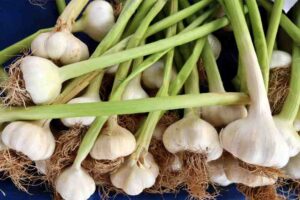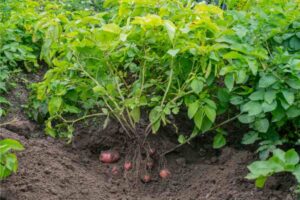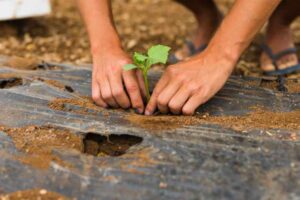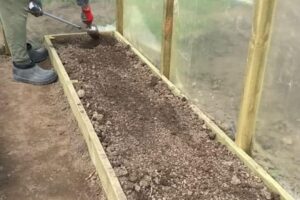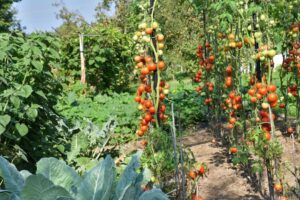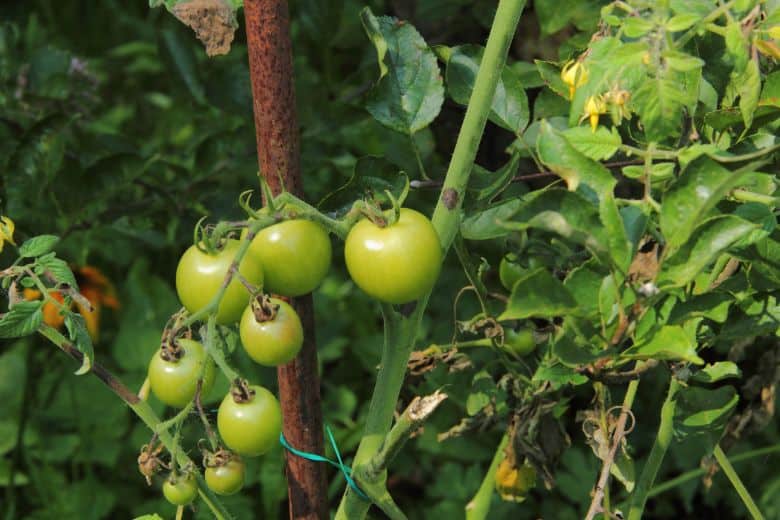
When it comes to planting tomatoes in Iowa, timing is everything. Tomatoes thrive best when soil and air temperatures are warm.
In Iowa, the ideal time to plant tomatoes outdoors is after the last frost date for your area, which is typically in late May.
However, there are a few things you need to do before and after planting to ensure your tomato
Types of Tomatoes to Plant in Iowa
- Slicing Tomatoes: These large tomato varieties are best for salads, sandwiches and eating fresh. Popular options include ‘Better Boy’, ‘Big Beef’, and ‘Brandywine’.
- Cherry/Grape Tomatoes: Small-fruited tomatoes are great for snacking. ‘Sungold’ and ‘Sweet 100s’ are disease-resistant varieties that produce loads of sweet, flavorful cherry tomatoes all season.
- Paste/Sauce Tomatoes: Tomatoes like ‘Roma’ and ‘San Marzano’ have thick walls and fewer seeds, making them ideal for canning sauce, paste, or ketchup.
- Heirloom Tomatoes: Heirloom varieties offer unique flavors, colors and textures. Try ‘Cherokee Purple’, ‘Brandywine’, or ‘Black Krim’ for an assortment of heirloom tastes.
- Disease-Resistant Varieties: In the Midwest, focus on tomatoes bred to withstand common diseases like late blight. Good options are ‘Bush Steak’, ‘Mountain Merit’, and ‘Mountain Fresh Plus’.
- Determinate Tomatoes: Bush-type tomatoes mature all at once, unlike vine-type varieties. Select determinates like ‘Pixie’ or ‘Little Victor’ for small gardens.
- Hybrid Tomatoes: Hybrids like ‘Celebrity’, ‘Better Boy’, and ‘Big Beef’ combine traits for high yields, flavor, and disease tolerance ideal for Iowa’s climate.
- For best results in Iowa, choose tomatoes adapted to short seasons, mid-range heights, and disease resistance. Consider sowing a mix of slicing, paste, cherry and heirloom varieties for continuous harvests and flavor variety.
Planting Techniques for Tomatoes in Iowa
Here’s a step-by-step guide to planting tomatoes in Iowa:
Step 1: Start Seeds Indoors 4-6 Weeks Before Last Frost Date
For an early harvest, start tomato seeds indoors 4-6 weeks before the last spring frost date. The last frost date for most of Iowa is between May 15th-31st, depending on your specific location. Check your local extension office for the exact date for your county. Starting seeds indoors allows you to get a jump start on the growing season.
Sow tomato seeds in small containers like seed starter trays or pots using a seed-starting mix. Place the containers in a warm, sunny windowsill and keep the soil moist. Transplant seedlings outdoors after the last frost date when they are 5-6 inches tall and have developed their first true leaves.
Step 2: Prepare Garden Soil in Early Spring
In early spring, before planting seeds or transplants outdoors, amend your garden soil with compost or other organic matter. Tomatoes are heavy feeders that require nutrient-rich soil. Dig compost or other organic matter like well-rotted manure into the top 6-8 inches of soil. This improves drainage and adds essential nutrients and microbes to feed your tomato plants.
Step 3: Raised Beds Warm Up More Quickly
Consider planting tomatoes in raised beds, which warm up more quickly than in-ground gardens in the spring. The elevated soil heats up from the sun’s rays, allowing you to plant tomatoes a week or two earlier than ground-level plots. Build raised beds 4-6 inches high using untreated wood, stones, bricks, or landscape timbers. Make sure to amend the soil in raised beds as well before planting.
Step 4: Harden Off Seedlings
Once tomato seedlings have reached the desired size indoors, they need to acclimate to the cooler temperatures and stronger sunlight outdoors before transplanting. This process is called “hardening off.” For one week before planting outside, place the seedlings in a partially sunny spot protected from wind. Gradually increase their sun and wind exposure each day to harden them off.
Step 5: Plant Seedlings After the Last Frost Date
The last spring frost date for most of Iowa is the recommended time to plant tomato seedlings outdoors. As long as nighttime lows remain above freezing, it’s safe to transplant seedlings into the ground or put them in containers outside after the last frost date. Space tomato plants 1-2 feet apart, depending on the variety. Water them in well after planting.
Step 6: Use Cages or Stakes for Support
Tomato plants need support as they grow tall to prevent damage from wind and the weight of fruit. When transplanting outside, place tomato cages, stakes, other supports in the hole or around each plant. The supports will strengthen the plant as it grows. You can also use pruning techniques like topping or suckering to control plant size if needed.
Step 7: Mulch Around Plants
After planting, apply a 2-3 inch layer of organic mulch such as straw, shredded leaves, or wood chips around the base of each tomato plant. Mulch helps conserve soil moisture, suppress weeds, and regulate soil temperature. Be sure not to pile mulch right up against the stem, as this can cause rot. Leave a few inches of space.
Step 8: Watch for Late Frosts
Although daytime temperatures may be warm enough for transplanting seedlings after the last spring frost date, there is still a chance of late frosts through May. Be prepared to cover or bring in tender tomato seedlings if frost is predicted overnight. Hot caps, floating row covers, or sheets will provide enough insulation to protect plants down to around 28°F. Remove covers during the day.
Step 9: Water Deeply Weekly
Once planted, tomatoes need about 1 inch of water per week, either from rain or irrigation. Water deeply to encourage deep root growth but avoid getting the foliage wet, which can lead to disease issues. Use drip irrigation, soaker hoses, or water at the soil level for even moisture distribution.
Step 10: Fertilize Monthly When Plants Bloom
Feed transplanted tomatoes with a balanced, water-soluble fertilizer monthly once flowering begins according to label instructions. A balanced fertilizer, such as 10-10-10, provides essential nutrients to produce healthy foliage and abundant fruit throughout the growing season. Side-dress with additional compost or manure as needed.
Step 11: Prune and Rotate Crops
Prune off any suckers, or non-fruiting stems, that form between the main stem and leaves. This helps direct energy into fruit production instead of extra foliage. After the first tomato harvest in late summer, pull out plants to make space for a cover crop or other fall vegetables. Rotate where you plant tomatoes each year to reduce disease problems.
Conclusion
By following these steps for planting tomatoes in Iowa – starting seeds indoors, prepping soil, hardening off and planting after the last frost – your tomato plants will get off to a healthy start and be well on their way to producing a bountiful harvest. With a little TLC, tomatoes can thrive when grown using these best practices tailored for the Iowa climate.

